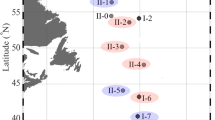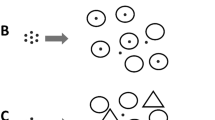Abstract
Culture studies of phage–host systems have shown that phage proliferation strongly depends on the physiological state of the host, but it is still unclear to what extent this holds true within aquatic ecosystems. We used a combination of flow sorting and electron microscopy to explore how the frequency of bacterial cells with attached viruses (FCAV), of visibly infected cells, and the number of intracellular viruses are distributed within five physiologic categories: cells with high (HNA) and low (LNA) nucleic acid content, with a compromised membrane, in division, and with an intact-looking morphology. FCAV was not different between the cellular physiologic categories, suggesting low influence of host physiology on viral adsorption. Infected cells were found within all the physiologic categories, besides the dividing cells, but showed different levels of new virion production, with the abundance of intracellular viruses ranked as follows: HNA > intact-looking cells > LNA > compromised membrane cells. These results favor the physiological control hypothesis of viral progeny production. The calculation of viral production rate of the HNA and LNA cells show that viral infection of HNA cells likely accounts for the majority of viral production. It also show that cells considered as less active can still act as resources for phages, although they contain much less intracellular phage particles.




Similar content being viewed by others
References
Abedon ST, Herschler TD, Stopar D (2001) Bacteriophage latent-period evolution as a response to resource availability. Appl Environ Microbiol 67:4233–4241
Bettarel Y, Sime-Ngando T, Amblard C, Dolan J (2004) Viral activity in two contrasting lake ecosystems. Appl Environ Microbiol 70:2941–2951
Bettarel Y, Arfi R, Bouvier T, Bouvy M, Briand E, Colombet J, Corbin D, Sime-Ngando T (2008) Virioplankton distribution and activity in a tropical eutrophicated bay. Estuar Coast Shelf Sci 80:425–429
Binder B (1999) Reconsidering the relationship between virally induced bacterial mortality and frequency of infected cells. Aquat Microb Ecol 18:207–215
Binetti AG, Quiberoni A, Reinheimer JA (2002) Phage adsorption to Streptococcus thermophilus. Influence of environmental factors and characterization of cell receptors. Food Res Int 35:73–83
Bouvier T, del Giorgio PA, Gasol JM (2007) A comparative study of the cytometric characteristics of high and low nucleic-acid bacterioplankton cells from different aquatic ecosystems. Environ Microbiol 9:2050–2066
Chen F, Lu JR, Binder BJ, Liu YC, Hodson RE (2001) Application of digital image analysis and flow cytometry to enumerate marine viruses stained with SYBR gold. Appl Environ Microbiol 67:539–545
Comas J, Vives-Rego J (1997) Assessment of the effects of gramicidin, formaldehyde, and surfactants on Escherichia coli by flow cytometry using nucleic acid and membrane potential dyes. Cytometry 29:58–64
Costerton JW (1979) The role of electron microscopy in the elucidation of bacterial structure and function. Ann Rev Microbiol 33:459–479
del Giorgio PA, Gasol JM (2008) Physiological structure and single-cell activity in marine bacterioplankton. In: Kirchman DL (ed) Microbial ecology of the oceans, 2nd edn. Wiley-Liss, NewYork, pp 243–298
del Giorgio PA, Bird DF, Prairie YT, Planas D (1996) Flow cytometric determination of bacterial abundance in lake plankton with the green nucleic acid stain SYTO 13. Limnol Oceanogr 41:783–789
del Giorgio PA, Bouvier TC (2002) Linking the physiologic and phylogenetic successions in free-living bacterial communities along an estuarine salinity gradient. Limnol Oceanogr 47:471–486
Delbrück M (1940) Adsorption of bacteriophage under various physiological conditions of the host. J Gen Physiol 20:631–642
Fuller R, Lovelock DW (1976) Microbial ultrastructure: the use of the electron microscope. Academic, London
Gasol JM, Zweifel UL, Peters F, Fuhrman JA, Hagström Å (1999) Significance of size and nucleic acid content heterogeneity as measured by flow cytometry in natural planktonic bacteria. Appl Environ Microbiol 65:4475–4483
Gasol JM, del Giorgio PA (2000) Using flow cytometry for counting natural planktonic bacteria and understanding the structure of planktonic bacterial communities. Sc Mar 64:197–224
Gnezda-Meijer K, Mahne I, Poljsak-Prijatelj M, Stopar D (2006) Host physiological status determines phage-like particle distribution in the lysate. FEMS Microbiol Ecol 55:136–145
Grégori G, Citterio S, Ghiani A, Labra M, Sgorbati S, Brown S, Denis M (2001) Resolution of viable and membrane compromised bacteria in freshwater and marine waters based on analytical flow cytometry and nucleic acid double staining. Appl Environ Microbiol 67:4662–4670
Hadas H, Einav M, Fishov I, Zaritsky A (1997) Bacteriophage T4 development depends on the physiology of its host Escherichia coli. Microbiol UK 143:179–185
Haugland RP (2005) The handbook. A guide to fluorescent probes and labeling technologies. Invitrogen Corp. 10 Ed
Heissenberger A, Leppard GG, Herndl GJ (1996) Relationship between the intracellular integrity and the morphology of the capsular envelope in attached and free-living marine bacteria. Appl Environ Microbiol 62:4521–4528
Hwang CH, Cho BC (2002) Virus-infected bacteria in oligotrophic open waters of the East Sea, Korea. Aquat Microb Ecol 30:1–9
Kokjohn TA, Sayler GS, Miller RV (1991) Attachment and replication of Pseudomonas aeruginosa bacteriophages under conditions simulating aquatic environments. J Gen Microbiol 137:661–666
Krueger AP (1931) The sorption of bacteriophage by living and dead susceptible bacteria. J Gen Physiol 14:493–516
Kudva IT, Jelacic S, Tarr PI, Youderian P, Hovde CJ (1999) Biocontrol of Escherichia coli O157 with O157-specific bacteriophages. Appl Environ Microbiol 65:3767–3773
Lebaron P, Servais P, Agogue H, Courties C, Joux F (2001) Does the high nucleic acid content of individual bacterial cells allow us to discriminate between active cells and inactive cells in aquatic systems? Appl Environ Microbiol 67:1775–1782
Legendre P (2005) Species associations: the Kendall coefficient of concordance revisited. J Agric Biol Environ Stat 10:226–245
Lenski RE (1988) Dynamics of interactions between bacteria and virulent bacteriophage. Adv Microb Ecol 10:1–44
Longnecker K, Sherr BF, Sherr EB (2006) Variation in cell-specific rates of leucine and thymidine incorporation by marine bacteria with high and with low nucleic acid content off the Oregon coast. Aquat Microb Ecol 43:113–125
Maranger R, del Giorgio PA, Bird DF (2002) Accumulation of damaged bacteria and viruses in lake water exposed to solar radiation. Aquat Microb Ecol 28:213–227
Morita RY (1993) Bioavailability of energy and the starvation state. In: Kjelleberg S (ed) Starvation in bacteria. Plenum, New York, pp 1–23
Moebus K (1987) Ecology of marine bacteriophages. In: Goyal SM, Gerba CP, Bitton G (eds) Phage ecology. Wiley, New York, pp 136–156
Parada V, Herndl GJ, Weinbauer MG (2006) Viral burst size of heterotrophic prokaryotes in aquatic systems. J Mar Biol Assoc UK 86:613–621
Peduzzi P, Schiemer F (2004) Bacteria and viruses in the water column of tropical freshwater reservoirs. Environ Microbiol 6:707–715
Pradeep Ram AS, Sime-Ngando T (2010) Resources drive trade-off between viral lifestyles in the plankton: evidence from freshwater microbial microcosms. Environ Microbiol 12:467–479
Quiberoni A, Reinheimer JA (1998) Physicochemical characterization of phage adsorption to Lactobacillus helveticus ATCC 15807 cells. J Appl Microbiol 85:762–768
Roszak DB, Colwell RR (1987) Survival strategies of bacteria in the natural environment. Microbiol Rev 51:365–379
Schlesinger M (1932) Adsorption of bacteriophage to homologous bacteria. II. Quantitative investigation of adsorption velocity- and saturation, estimation of particle size of the bacteriophage. Z Hyg Immun Itatsforsch 114:149–160
Schrader HS, Schrader JO, Walker JJ, Bruggemann NB, Vanderloop JM, Shaffer JJ, Kokjohn TA (1997) Effects of host starvation on bacteriophage dynamics. In: Morita RY (ed) Bacteria in oligotrophic environments: starvation-survival life style. Chapman & Hall, New York
Schrader HS, Schrader JO, Walker JJ, Wolf TA, Nickerson KW, Kokjohn TA (1997) Bacteriophage infection and multiplication occur in P. aeruginosa starved for 5 years. Can J Microbiol 43:1157–1163
Slatkin M (1974) Hedging ones evolutionary bets. Nature 250:704–705
Stoderegger KE, Herndl GJ (2002) Distribution of capsulated bacterioplankton in the North Atlantic and North Sea. Microb Ecol 44:154–163
Troussellier M, Bouvy M, Courties C, Dupuis C (1997) Variation of carbon content among bacterial species under starvation condition. Aquat Microb Ecol 13:113–119
Wang Y, Hammes F, Boon N, Chami M, Egli T (2009) Isolation and characterization of low nucleic acid (LNA)-content bacteria. ISME J 3:889–902
Weinbauer MG (2004) Ecology of prokaryotic viruses. FEMS Microbiol Rev 28:127–181
Weinbauer MG, Brettar I, Höfle MG (2003) Lysogeny and virus-induced mortality of bacterioplankton in surface, deep, and anoxic marine waters. Limnol Oceanogr 48:1457–1465
Weinbauer MG, Peduzzi P (1994) Frequency, size and distribution of bacteriophages in different marine bacterial morphotypes. Mar Ecol Prog Ser 108:11–20
Weinbauer MG, Winter C, Hofle MG (2002) Reconsidering transmission electron microscopy based estimates of viral infection of bacterioplankton using conversion factors derived from natural communities. Aquat Microb Ecol 27:103–110
Wilhelm SW, Weinbauer MG, Suttle CA, Pledger RJ, Mitchell DL (1998) Measurements of DNA damage and photoreactivation imply that most viruses in marine surface waters are infective. Aquat Microb Ecol 14:215–222
Williams SC, Hong Y, Danavall DCA, Howard-Jones MH, Gibson D, Frischer ME, Verity PG (1998) Distinguishing between living and nonliving bacteria: evaluation of the vital stain propidium iodide and its combined use with molecular probes in aquatic samples. J Microbiol Methodes 32:225–236
You LC, Suthers PF, Yin J (2002) Effects of Escherichia coli physiology on growth of phage T7 in vivo and in silico. J Bacteriol 184:1888–1894
Zubkov MV, Fuchs BM, Burkill PH, Amann R (2001) Comparison of cellular and biomass specific activities of dominant bacterioplankton groups in stratified waters of the Celtic Sea. Appl Environ Microbiol 67:5210–5218
Acknowledgments
We thank Lionel Viard for his help during experimental setup, Corinne Bouvier for helpful advices for experimental design and sampling, and Rutger de Wit, Behzad Mostajir, and Marc Troussellier for stimulating discussions. We also gratefully acknowledge the comments of P. del Giorgio on this manuscript and D. Mouillot for his help with statistical analysis. This work was supported by the French program PNEC (10301705 to TB) and the ANR AQUAPHAGE (ANR07 BIODIV 015–02 to TB).
Author information
Authors and Affiliations
Corresponding author
Rights and permissions
About this article
Cite this article
Bouvier, T., Maurice, C.F. A Single-Cell Analysis of Virioplankton Adsorption, Infection, and Intracellular Abundance in Different Bacterioplankton Physiologic Categories. Microb Ecol 62, 669–678 (2011). https://doi.org/10.1007/s00248-011-9862-3
Received:
Accepted:
Published:
Issue Date:
DOI: https://doi.org/10.1007/s00248-011-9862-3




